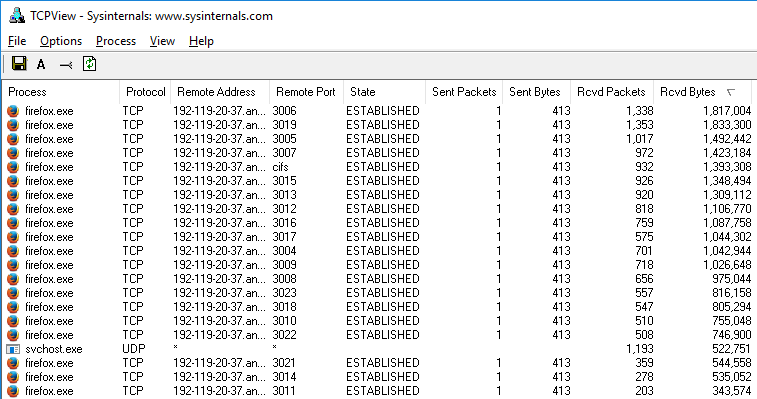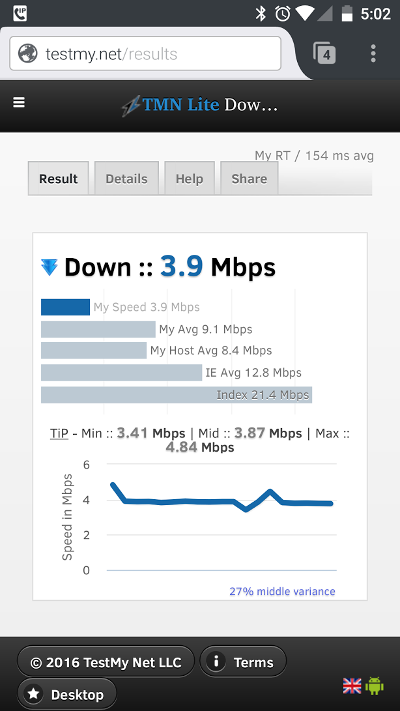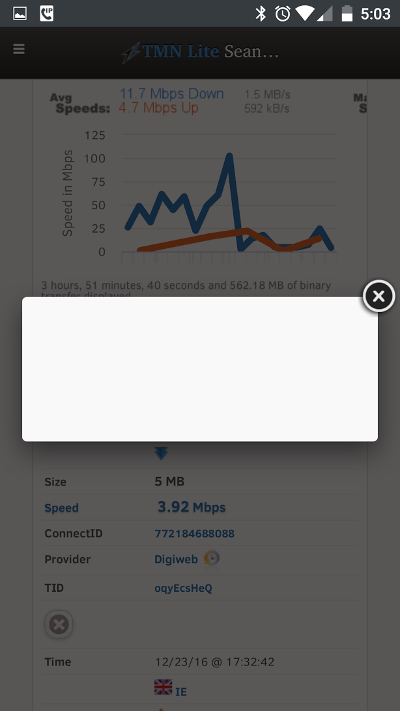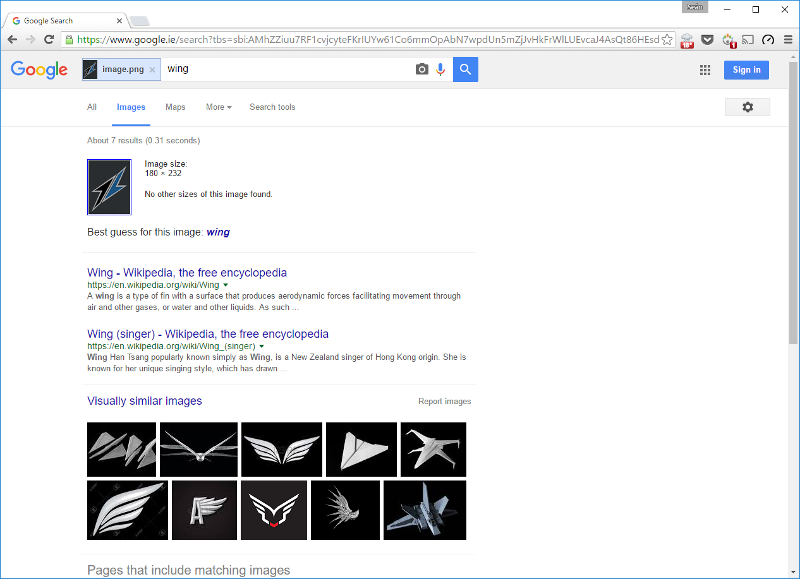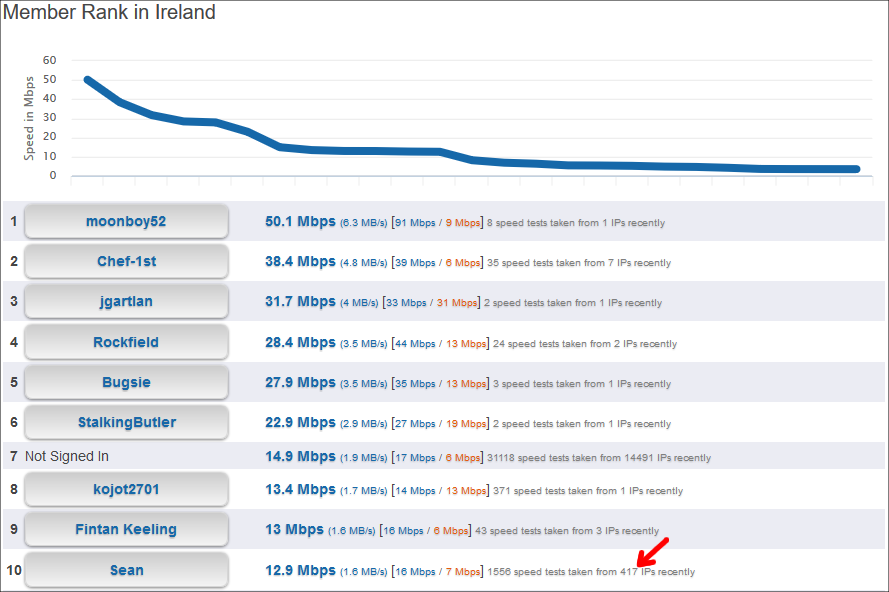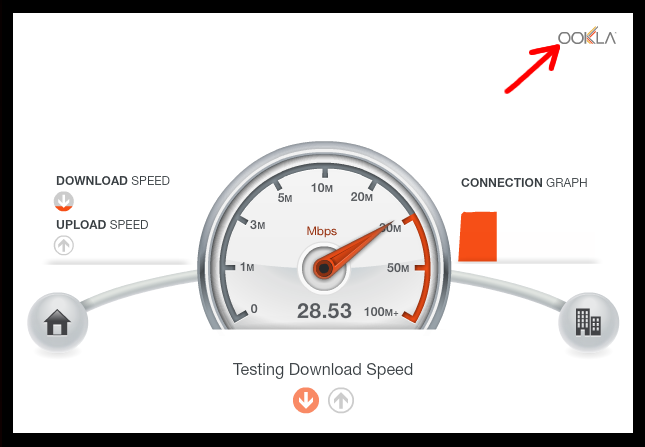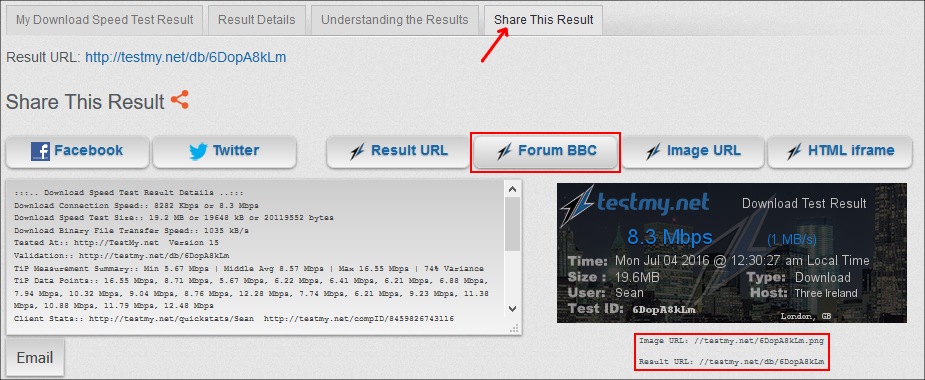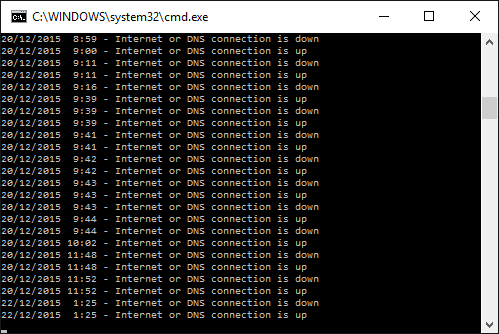-
Posts
363 -
Joined
-
Last visited
-
Days Won
87 -
Speed Test
My Results
Everything posted by Sean
-
I suggest getting a SIM for each of the prepay providers and run some speed tests during peak time, i.e. 8pm to 10pm. 4G can be surprisingly quick, particularly on cell towers with low contention and those operating on larger bandwidths such as 20MHz. My fastest speed test with TestMy on 4G was 102Mbps. On the other hand, if there are a lot of users in the area on the one provider, then the speed can severely plummet, particularly if if many are streaming at the same time. For example, I am currently using the Three 4G network to supplement my DSL connection. The speed test on the left is at the moment (off-peak) and the right speed test was yesterday evening near midnight (peak): For comparison, my DSL connection usually hits 3.9Mbps regardless of the time of day.
-
From a quick check in TCPView, Google fiber's speed test is multi-threaded. Based on a test my with my connection (which only peaks about 45Mbps), it made 20 simultaneous connections: Although TestMy has a multi-threaded test option (default test is a single connection), the 200MB maximum block size is not sufficient to properly test Gigabit connections as the test will complete in under 2 seconds (900Mbps = 112.5MB per second). So for measuring your peak speed, the Google fibre test will likely be more accurate. On the other hand, the normal TestMy linear test will give an idea of what your connection is capable of with a single connection, similar to downloading a very large file with a web browser or FTP transfer. If you are getting in the 800Mbps range, your connection is fine. However, if it's much lower, e.g. below 500Mbps, then there is probably something limiting what you can achieve over a single connection, which the multi-threaded speed tests don't show, in which cause you would only be able to achieve the multi-threaded test result with a multi-threaded download manager, e.g. Firefox's DownThemAll plug-in which splits a large download into multiple segments and downloads these segments simultaneously.
-
This issue seems to have resolved itself since posting as it now shows the TID graphs on all my devices.
-

U.S. average Internet speed is 22.6 Mbps? (source wanted)
Sean replied to MicFid's topic in General Discussion
As far as I'm aware of, TestMy calculates its averages based on all test results for a given host, city, region, etc. Ookla's Speedtest awards are higher, but they only use the results from the fastest 10% of the test results: So peak time congestion dips, line issues, etc. will not impact an ISP's "average" performance as long as at least 10% of customers were getting what they are paying for. So a fixed wireless ISP could rank pretty well even if over half the customers get a tiny fraction of what they are paying for, as long as 10% of the speed tests were conducted off-peak or by customers on rural lightly loaded cell towers. -
When I click any of the TID links on the test results page, it shows a blank pop-up: It also does the same thing on my phone's browser. The test result graph shows when the test completes, this in case on my DSL line. However, when I go to the test results and touch the TID link, it shows up blank:
-
Test run on the Irish Three 4G network in Donegal town, possibly LTE+ (OnePlus 2 phone): It's also my fastest TestMy download result to date, certainly did not expect to see my first >100Mbps result on a cellular network, let alone the Three network especially with the past experience of prioritising/throttling ports. As far as I can tell, they treat port 80 and 8080 equally now and the above test was a normal linear HTTP test with the UK server.
-
The spike at the start can sometimes be caused by the Internet Security (virus checker) or the browser itself. For example, many Internet Security products start analysing the data of each connection before passing the data stream to the browser. In the split second this happens, the data coming in is queued. Once the Internet security product is satisfied this is not a threat, it passes this chunk along with any queued data to the browser. To the speed test, this burst of data appears as the spike at the start of the graph. I often see this happen with the Firefox web browser, which also seems to hold up the data stream near the start of the test. For example, occasionally when I start a speed test, Firefox stutters and then seems to skip ahead 10% where the speed test script sees this chunk as a speed spike. The following shows an example of the spike where I did a test on Firefox for Android, in this case over the Meteor LTE (4G) network.
-
What type of Internet connection is this? E.g. for example, VDSL, Cable, Fixed Wireless, LTE, etc. If you connect to your ISP with a wireless connection, the bandwidth shared with everyone else in line of sight with the base station on that ISP. This is similar with 3G and 4G (LTE) based connections where the cell tower bandwidth is shared amongst the customers connected to that cell tower. In this case, the drop-off is due to contention where other users are streaming or downloading content.
-

Does checking internet speed online, in anyway affects bandwidth?
Sean replied to nevize's topic in General Discussion
If this advice was given for a mobile Internet connection, what they likely mean is that running speed tests gobbles up the available data allowance. For example, many of the popular mobile phone packages in Ireland and the UK have a 1GB data allowance, such as the following example I picked from the UK O2 website: Running a speed test on 4G typically uses up to 100MB per direction per test depending on the 4G speed. For example, if one is getting around 50Mbps, TestMy will usually download about 60MB in total. This is double for the uplink direction as TestMy first downloads each block size to run the upload test. So for a typical 20Mbps uplink, it will use around 40MB in total. For faster 4G areas such as 20MHz areas or LTE Advanced (or 4G+), these figures double or triple. Speedtest.net uses a similar amount of data, around 100MB total for a 4G connection delivering about 50Mbps down and 20Mbps up and I'm sure it's much the same with other speed test providers. So assuming a speed test uses about 100MB per test (combined up & down) and the user has a 1GB monthly allowance like the above tariff, that person just needs to run the test 10 times to use up their data allowance without doing anything else online. Basically, for anyone with a 2GB or lower monthly data allowance on their mobile handset, run the speed tests sparingly on 3G and avoid running speed tests if at all possible on 4G, apart from on the last day of the billing cycle and you have at least 200MB left (500MB for an LTE Advanced / 4G+ area). -

Auto Speed Test stopped with "Server not found"
Sean replied to Drip LeBuk's topic in General Discussion
You can try the command line based test I wrote in this earlier thread. That batch file runs a TestMy download and upload test in 15 minute intervals until the command prompt window is closed and is not affected by Internet downtime. I wrote it when I was with a fixed wireless ISP that kept going down, which gave me the same issue with the site's auto test. One small side effect with the script is that it runs each test in a new tab, so you'll probably have a 100 or so tabs open by the time you return. -
One possibility is that the satellite provider is using a cache proxy that is interfering with the speed test. For example, some satellite proxies try caching the whole page before sending the lot in one chunk over the satellite. This reduces the time a page takes to load as the individual page element requests (for images, javascript, css files, etc.) are intercepted and served by the satellite modem. As the TestMy download test is effectively one huge webpage, what's probably happening is that the satellite provider is trying to prefetch it and chocking on the size, particularly if it goes on to let's say 20+MB blocks that would be unusually large for a webpage. I've seen this issue also happen with transparent proxies such as Fiddler. What you can try is running a test with the HTTPS website https://testmy.net/download You will need to accept the security certificate warning that appears as the site uses a self-signed certificate. If that does not work, you can try downloading the '100mb' test block from http://mirror.leaseweb.com/speedtest/ (don't use the Microsoft Edge browser) and see what the download speed settles around during the test. Multiply this figure by 8 to convert the speed into Mbps. For example, if you get a download speed of 1.5MB/s, then 1.5 x 8 = 12Mbps.
-
Besides all the security updates and holes, the most annoying thing I find with Flash is that it is continuing to get more resource intensive and is causing havoc with streaming services on low end hardware. Earlier this year, I bought a Lenovo TV stick (Atom Z3735F), which is a PC (running Windows 10) in stick that plugs directly into the TV's HDMI port. Plug in a wireless keyboard and mouse, the TV effectively becomes the monitor similar to a home theatre PC. It has no problem playing 1080p from any video files I tried and similarly has no problem streaming 1080p on YouTube and most other HTML5 based streaming services. However, when it comes to Flash based streaming websites, it is hit & miss as to whether it streams in standard definition and very few streaming services work in 720p, let alone 1080p with Flash, despite no problems whatsoever with HTML5 streaming. Even on the few Flash websites that stream fine in standard definition, the ad-breaks is the killer as there is no way to skip the ads that insist in playing in what appears to be 1080p frame by frame with the audio blipping as it struggles with each second of the ad. I can now see why people prefer to use Android based set-top boxes (which use Apps instead of flash for streaming) or home theatre PCs with higher end CPUs just to cater for those websites that insist on using their CPU-hogging Flash player.
-

Why Do My Results Differ From Speedtest.net / Ookla Speed Tests?
Sean replied to CA3LE's topic in General Discussion
I have the same experience with 4G (cellular LTE) based broadband connections, such as when positioning a directional antenna. When the network is quiet (e.g. early on a weekend morning), there can be a large variation between what SpeedTest and TestMy reports if the antenna is not aimed correctly. Once the antenna is carefully aimed, the TestMy results climb up towards what Speedtest reports. It's similar also if there are swaying branches in line of sight as Speedtest will again ignore the brief dips as if the bandwidth is sustained. If Speedtest measured road trip speeds, their speed test methodology would eliminate traffic lights, construction zones, slow vehicles, busy junctions and everything else that accounted for the slowest 30% of the journey. If TestMy measured road trips, it would run a stopwatch from the moment of departure to the moment of arrival. Of course like the Speedtest fanatics, there would be those that would argue the same for road trip measurements - "What if that construction zone was not there, those traffic lights were green, no accident on the route, ..." -
I just tried it on my end and got a totally different result: I tried again with the avatar as tdawnaz suggested and this one gave a better result:
-
Although my LTE connection is limited to about 16Mbps up, it did make a noticeable difference here also: Default (131072) and after (524288): The Android Firefox does not seem to have this setting, however, I have noticed it has been producing faster upload results than Firefox on my PC, so it probably uses a larger send buffer by default. It consistently produces faster upload results than the Chrome App, which seems to cap out about 12Mbps.
-
I do like the way satellite ISPs provide peak and off-peak bundles as it effectively allows them to provide larger monthly bundles without adding further congestion to day time usage, since not many people care how slow the Internet gets between 2am and 8am while they are asleep. This is something I really wish the cellular LTE (4G) broadband providers would do here in Ireland. The Three here has popular plans between 60GB and 250GB per month and this is metered 24 hours a day, so there is no incentive for people to do their bulk downloading overnight. Unsurprisingly their network can get incredibly slow in the evenings such as below 2Mbps compared to 40+Mbps early in the day. The satellite Internet providers do a similar approach by offering an unmetered overnight usage. However, unlike the speeds above, so far pretty much every speed test I've seen by a satellite ISP here is below 1Mbps (downlink) in the evening and am fairly sure the maximum I've seen anyone show me was under 4Mbps.
-
At home, my main Internet connection is a DSL connection that gives a fairly consistent 3.9Mbps down and about 400Kbps up. I tried a fixed wireless service about a year ago that was a complete disaster. Lately I'm using a makeshift LTE based connection that fluctuates between 4Mbps and 45Mbps down and 10Mbps to 12Mbps up, going by TestMy. As with phone cellular data connections, the IP address changes quite regularly, likely once or twice a day. In addition, while out and about, I run tests with my phone's data and similar also in places that offer free Wi-Fi. I didn't realise just how many different IP addresses I clocked up until I was browsing through the Top 10 list for Ireland. I'm actually surprised to be in this list also as I certainly don't have the 10,000th fastest connection in Ireland, let alone the 10th. Just a pity that most people in Ireland don't create an account to log their readings as that #7 rank indeed shows that the majority of tests here are not with a signed in user.
-
To rule out Wi-Fi or interference being the culprit, I suggest trying with network cable. Speedtest.net does a pretty good job at ironing out all the dips in a speed test which can make an erratic Wi-Fi connection look about as good as a wired connection. Most Internet provider provided speed tests are powered by Ookla, i.e. Speedtest.net in disguise. The usual tale-tale sign is the word 'Ookla' mentioned somewhere in the speed test screen, such as the following example in Pulse8's speed test:
-

Router Finally Failed - new one fixed speed issues
Sean replied to Pgoodwin1's topic in General Discussion
What's interesting is that every single D-Link router I dealt with including corporate VPN routers all have a similar way of failing with the first symptom being webpages starting to hang regardless of the website, including the router's own GUI pages. This then progresses with general slow down of connections such as persistent buffering in YouTube even when no one else is using the connection. The D-link dfl-700 at my workplace was notorious for blowing power supplies and like Murphy's law, one would blow during a holiday period and I was glad when it was finally replaced. it died in the same way with erratic Internet throughput. -
That's a very impressive downlink speed for a satellite link, especially for the time when most people are online. For the upload test, I recommend trying a larger block size. On the Upload page, select '6MB' for the manual test size drop-down and allow a minute or two to complete.
-
It looks like this bug has sprung up again, this time on the "Share this result" tab after a test completes. The 'Forum BBC' button and the links below the image are missing the 'http': I only just noticed this when I saw the odd person post TestMy results on a forum with the 'http' missing before they edited their post.
-
I sure would love to have that speed... It does bug me also that most people I've encountered that sees a much lower speed on TestMy automatically puts the fault at TestMy instead of their ISP not being able to measure their connection as I've lost count of the number of times I've tried explaining why the two sites give such different results. Here, I'm talking about speeds in the 50Mbps to 100Mbps region where TestMy may throw up 6 to 8Mbps while Speedtest.net throws up 40 to 50Mbps, such as what I see on my 4G connection from time to time. The primarily reason is that Speedtest.net always runs its test multi-threaded and discards the 30% lowest readings during its test, while TestMy makes a linear connection to the Test server and factors in the entire test including dips in its test result. So when my 4G connection is showing a test result of 6Mbps, I know that ~750KB/s is what to expect from individual downloads and generally that's the case, even when Speedtest.net claims I'm getting 40+Mbps. This is especially important with streaming services as a Speedtest.net result of let's say 20Mbps does not necessarily mean that YouTube can stream video at 6Mbps for 1080p video. Another way to double-check your connection is with a download from Leaseweb's test file set. Start the download of a large file (e.g. 1000MB sample) and wait a few seconds for the transfer rate figure settles. Multiply this figure by 8 to convert to Mbps and you should get what your ISP is sustaining in this transfer. For me, this generally matches up with what I get with the TestMy UK and Germany servers nearest to me and it's very unlikely that the bottleneck along the route is at Leaseweb's end.
-
Despite all the hype over 4G these days, I recently decided to go back to 3G with my mobile provider. What's really surprising is just how much bandwidth they can squeeze even over 3G as I remember when 4G first launched, the maximum speed I've seen with any 3G provider was about 8Mbps, with speeds of 3Mbps or less being more common. The following is a speed test I conducted just a short while ago with my mobile operator Meteor in Ireland. This is HSPA+ (3G), which I'm paying €10/month for and has a 7.5GB cap. Sure I could pay €10 more for 4G and double the cap, but I wasn't even getting 1/10th this with my previous mobile provider Three on their 4G network!: I would be curious to to see if anyone else is getting anything better with 3G. Even the Vodafone 4G network here which is hyped for delivering 100Mbps results on Ookla was only delivering about 20mbps at times with TestMy when I tried their network for a month back in January. While many areas still give about 10Mbps with Meteor, for me it's still fast enough for pretty much everything I do with my smartphone, including YouTube in HD.
-
With my last ISP that was terrible for going down, I wrote a command line script to do just that, putting the down and up times into a log file. It pings the Google DNS every 30 seconds and if it fails to reply three times in a row, it adds a line to the log file that the connection is down along with the time & date. Once the pings start replying again, it adds another line mentioning when it went up. It also displays this info on screen: To use the script, copy & paste the following into Notepad and save it as "NetTest.bat" somewhere handy, such as on the desktop: @echo off set Delay=30 echo Connection log script started: %date% %time:~0,5% echo Connection log script started: %date% %time:~0,5% >>"Outage log.txt" :repeat ping -n %Delay% localhost >nul ping -n 1 www.google.ie >nul &&goto repeat set OutageTime=%time:~0,5% set OutageDate=%date% ping -n 1 www.google.com >nul &&goto repeat ping -n 1 www.google.com >nul &&goto repeat echo %date% %time:~0,5% - Internet or DNS connection is down :outagerep ping -n 1 www.google.ie >nul &&goto backonline goto outagerep :backonline set UpDate= if not "%date%"=="%OutageDate%" set UpDate= %date% echo Link/DNS outage: %OutageDate% %OutageTime% to%UpDate% %time:~0,5% >>"Outage log.txt" echo %date% %time:~0,5% - Internet or DNS connection is up goto repeat Just double-click the saved file to run it, minimise it and leave it to run in the background..

